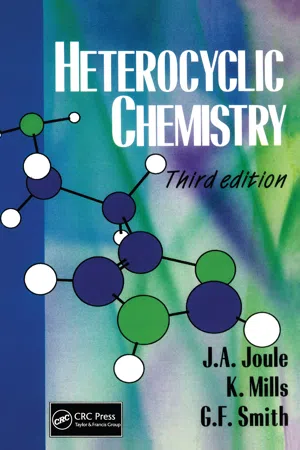
eBook - ePub
Heterocyclic Chemistry, 3rd Edition
John A. Joule
This is a test
Compartir libro
- English
- ePUB (apto para móviles)
- Disponible en iOS y Android
eBook - ePub
Heterocyclic Chemistry, 3rd Edition
John A. Joule
Detalles del libro
Vista previa del libro
Índice
Citas
Información del libro
Covering the fundamentals of heterocyclic reactivity and synthesis, this book teaches the subject in a way that is understandable to graduate students. Recognizing the level at which heterocyclic chemistry is often taught, the authors have included advanced material that make it appropriate for postgraduate courses. The text discusses the chemical reactivity and synthesis of particular heterocyclic systems. Exercises and solutions help students understand and apply the principles. Original references are included throughout, as well as many review references.
Preguntas frecuentes
¿Cómo cancelo mi suscripción?
¿Cómo descargo los libros?
Por el momento, todos nuestros libros ePub adaptables a dispositivos móviles se pueden descargar a través de la aplicación. La mayor parte de nuestros PDF también se puede descargar y ya estamos trabajando para que el resto también sea descargable. Obtén más información aquí.
¿En qué se diferencian los planes de precios?
Ambos planes te permiten acceder por completo a la biblioteca y a todas las funciones de Perlego. Las únicas diferencias son el precio y el período de suscripción: con el plan anual ahorrarás en torno a un 30 % en comparación con 12 meses de un plan mensual.
¿Qué es Perlego?
Somos un servicio de suscripción de libros de texto en línea que te permite acceder a toda una biblioteca en línea por menos de lo que cuesta un libro al mes. Con más de un millón de libros sobre más de 1000 categorías, ¡tenemos todo lo que necesitas! Obtén más información aquí.
¿Perlego ofrece la función de texto a voz?
Busca el símbolo de lectura en voz alta en tu próximo libro para ver si puedes escucharlo. La herramienta de lectura en voz alta lee el texto en voz alta por ti, resaltando el texto a medida que se lee. Puedes pausarla, acelerarla y ralentizarla. Obtén más información aquí.
¿Es Heterocyclic Chemistry, 3rd Edition un PDF/ePUB en línea?
Sí, puedes acceder a Heterocyclic Chemistry, 3rd Edition de John A. Joule en formato PDF o ePUB, así como a otros libros populares de Sciences physiques y Chimie. Tenemos más de un millón de libros disponibles en nuestro catálogo para que explores.
Información
Structures and main physical properties of aromatic heterocycles | 1 |
This chapter describes the structures of aromatic heterocycles and gives a brief summary of some physical properties.1 The treatment we use is the valence-bond description, which we believe is sufficient for the understanding of all heterocyclic reactivity, perhaps save some very subtle effects, and is certainly sufficient for a general text-book on the subject. The more fundamental molecular-orbital description of aromatic systems is still not so relevant to the day-to-day interpretation of heterocyclic reactivity, though it is necessary in some cases to utilise frontier orbital considerations,2 however such situations do not fall within the scope of this book.
1.1 CARBOCYCLIC AROMATIC SYSTEMS
1.1.1 Structures of benzene and naphthalene
The concept of aromaticity as represented by benzene is a familiar and relatively simple one. The difference between benzene on the one hand and alkenes on the other is well known: the latter react by addition with electrophiles, such as bromine, whereas benzene reacts only under much more forcing conditions and then nearly always by substitution. The difference is due to the cyclic arrangement of six π-electrons in benzene: this forms a conjugated molecular orbital system which is thermodynamically much more stable than a corresponding non-cyclically conjugated system. The additional stabilisation results in a diminished tendency to react by addition and a greater tendency to react by substitution for, in the latter manner, survival of the original cyclic conjugated system of electrons is ensured in the product. A general rule proposed by Hückel in 1931 states that aromaticity is observed in cyclically conjugated systems of 4n + 2 electrons, that is with 2, 6, 10, 14, etc., π-electrons; by far the majority of monocyclic aromatic, and heteroaromatic, systems are those with 6 π-electrons.
In this book we use ...